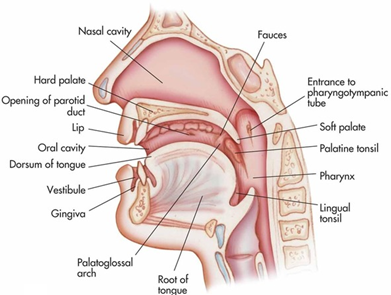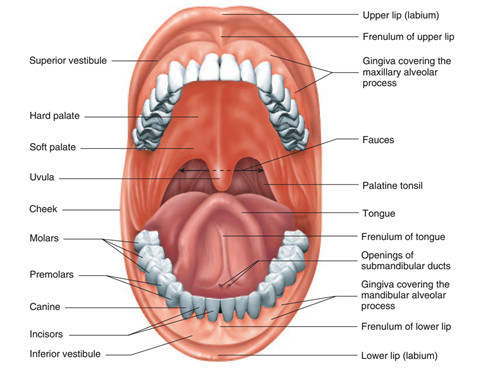Science > Biology > Digestion and absorption in Human > Buccal cavity – Mouth
The digestive system in humans consists of an alimentary canal and associated digestive glands. The human alimentary canal (aliment: nourish) is a continuous muscular digestive tube about 8 to 10 m long that runs through the body. It is open at two ends with the openings, which are mouth at the anterior end and anus at the posterior end. It performs the function of the digestion of the food. It breaks the food down into smaller substances and absorbs the digested food. In this article, we shall study the mouth and the buccal cavity.
Lips (labia oris):
The lips are soft, fleshy structures that form the anterior border of the external opening of the mouth. The lips are very flexible and elastic structures and contain many collagen and elastin fibers and adipose tissue covered by a thin layer of stratified squamous epithelium. The exterior of the lips is continuous with the skin and is covered by keratinized epithelium, while the inner surface is continuous with the mucous membrane of the mouth and is covered by non-keratinized epithelium. The inner surface of each lip is connected in the middle line to the corresponding gum by a fold of mucous membrane, the frenulum—the upper being the larger. The color from the underlying blood vessels can be seen through the relatively transparent epithelium tissues, giving the lips a reddish-pink to dark red appearance, depending on the overlying pigment.
Cheeks (buccae):
They are fleshy structures which form the sides of the face and are continuous in front with the lips. Similar to the lips, the exterior of the cheeks is covered in keratinized stratified squamous epithelium continuous with the skin and the interior is covered in nonkeratinized stratified squamous epithelium continuous with the mucous membrane. Between the epithelium, layers are layers of connective tissues, nerves, and muscles. In particular, the muscles of the cheeks include the buccinator, orbicularis oris and zygomaticus major, which move the lips and cheeks.
The lips and cheeks are important in the processes of mastication and speech. They help manipulate food within the mouth and hold it in place while the teeth crush or tear it.
Mouth:
The mouth is the entry point for food. This is the uppermost transverse slit-like opening of the alimentary canal. It is bound by the upper lip and the lower lip. The mouth is used to ingest the food. The mouth leads into the vestibule.
Oral cavity:
The mouth cavity is divided into two sections: The first section is called Vestibule (vestibulum oris) and the second section is the Oral Cavity Proper (cavum oris proprium).
Vestibule:
It is narrow space enclosed between the lips and cheeks externally and a pair of jaws internally, Its lining contains mucous glands. The vestibules lead into the oral cavity proper.
Oral cavity Proper:
The mouth, is bounded by the lips anteriorly, the fauces posteriorly, the cheeks laterally. It is bounded laterally and in front by the alveolar arches with their contained teeth; behind, it communicates with the pharynx. The upper jaw is fixed, which forms the roof of the mouth cavity and consists of palate, teeth, and gums surrounding the teeth. The lower jaw is movable and forms the floor of the mouth cavity, which consists of the tongue along with the teeth and gums surrounding them. The oral cavity is lined with moist stratified squamous epithelium, which provides protection against abrasion.


The main parts of the buccal cavity or an oral cavity are as follows:
Palate:
In humans, the buccal cavity and the nasal cavity are separated by the palate. Palate forms the roof of the oral or buccal cavity. The palate consists of two parts, an anterior bony part, the hard palate, and a posterior, non-bony part, the soft palate, which consists of skeletal muscle and connective tissue. Hard palate is supported by bones, Its mucous membrane bears transverse ridges called rugae. Which keep the food in place during mastication. The smooth-surfaced soft palate makes swallowing easy. The posterior end of soft palate hangs down as a small flap called the uvula or velum palati. During swallowing process, the uvula prevents food from passing into the nasal cavity by closing the internal nares. Palatine tonsils are located in the lateral wall of the fauces.
Tongue
The tongue is a muscular fleshy, triangular shape, highly mobile organ which lies along the floor of the buccal cavity. It is a large, muscular organ, which occupies most of the oral cavity and can take up a variety of shapes and positions. it is actually an organ made of epithelium, several skeletal muscles, nerves, and connective tissues. The anterior part of the tongue is relatively free and is attached to the floor of the mouth by a thin fold of tissue called the frenulum linguae. The intrinsic muscles in tongue are largely responsible for changing the shape of the tongue, such as flattening and elevating the tongue during drinking and swallowing. The extrinsic tongue muscles protrude and retract the tongue, move it from side to side, and change its shape. Mucous membrane secrets mucus that keeps the tongue moist.

Papillae on Tongue:
The tongue contains many small ridges known as lingual papillae that help it to grip and move food around the mouth. There are three types of papillae.
- Vallate Paillae: They are 8 to 12 in numbers and are arranged in an inverted V at the posterior part of tongue. Each papilla bears up to 100 taste buds.
- Fungiform Papillae: They are mushroom-shaped and are more numerous near the tip of the tongue. Each papilla bears about 5 taste buds.
- Filiform Papillae: They are smallest papillae and are thread-like. They are distributed on 2/3rd portion of anterior tongue. They do not have taste buds. They are tactile receptors.

Taste Buds:
Taste buds are hidden in valleys around some of the papillae and produce the sense of taste by detecting chemicals found in food. The taste buds located at the tip of the tongue, taste for sweets. Those presents on sides, taste for sour and salt. Those located at the posterior part of the tongue are meant for bitter taste.

The major functions of the tongue are the sense of Taste, organ of speech, oral cleansing of the mouth, holding the food in place during mastication, and Squeezing food into the oropharynx while swallowing.

Previous Topic: Alimentary canal: Brief Idea
Next Topic: Human Digestive System: Buccal Cavity: Teeth